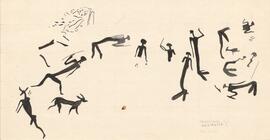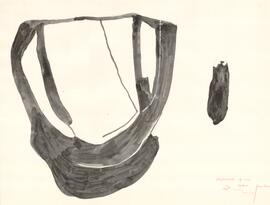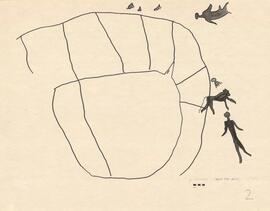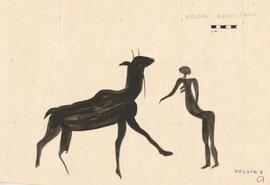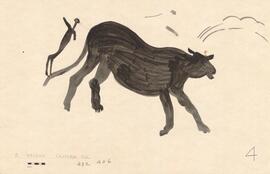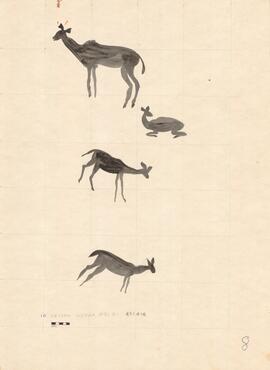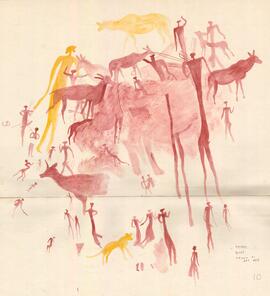Identity area
Reference code
Title
Date(s)
Level of description
Extent and medium
Context area
Name of creator
Name of creator
Biographical history
Background of the Recorder
The Rock Art Research Institute had its small beginnings in 1979 when Professor David Lewis-Williams moved from the Social Anthropology Department at the University of the Witwatersrand to the Archaeology Department. A few years later, in 1983, he started a research project focused on surveying and recording the rock art of the Harrismith district, South Africa. This project was headed by Professor Lewis-Williams, with Bruce Fordyce as the only other researcher, and was funded by the Human Sciences Research Council (HSRC). This project grew and the necessity for interpretation of the rock art, not just finding the rock art sites, became a primary focus. In 1986 the entity became more widely recognized and, through a series of successful projects, achieved Unit status becoming the Rock Art Research Unit (RARU), with Professor Lewis-Williams as the director of the Unit. The HSRC still funded the Unit, and additional funding came from the Centre for Science Development, as well as from Wits University. Some of the people employed (full or part time, or as research students) by RARU are Terence Kohler (1984), Conrad Steenkamp (1984), Paul den Hoed (1984-1985), Zachary Kingdon (1986-1987), Colin Campbell (1987-1988), Thomas Dowson (1988-1994), Anne Holliday (1989-1995), Geoff Blundell (from 1993), Sven Ouzman (from 1993). In 2000, with the Professor Lewis-Williams's imminent retirement, Professor Barry Mendelow, then the Deputy Vice Chancellor, suggested that the Unit be ungraded to an institute. A unit is closed if the director leaves, but an institute can continue under different directorship. Institute status is the highest research status conferred by Wits University, and it was awarded to the Unit to recognise the high level of achievement in research publications and the breadth of research talent built up during Professor Lewis-Williams's twenty-one year directorship. Today the Rock Art Research Institute (RARI) is funded by the National Research Foundation, Wits University's own Research Fund and the Anglo-American Chairman's Fund. Some activities have been and are privately resourced. Dr Benjamin Smith became the new director of the Institute after Professor Lewis-Williams. He is still the director today. RARI is dedicated to developing an understanding of rock art by researching indigenous beliefs, rituals, customs and lifeways. Research is currently underway in all South African provinces as well as in Zimbabwe, Swaziland, Lesotho, Botswana, Mozambique, Zambia, Malawi, Tanzania and Kenya. Research therefore includes the rock arts of San and Pygmy hunter-gatherers, Khoi and Nilotic pastoralists, as well as of African farmers, such as the Chewa and the Northern Sotho. Underpinning this diverse research is a focus on the complex symbolism of African image-making. RARI has become one of the largest specialist rock art institutions in the world, attracting students and researchers from around the world. It is a leading centre for rock art training and offers undergraduate and post-graduate courses in rock art recording, interpretation and management. It is also active in rock art conservation and in the development and management of rock art tourism in South Africa. Included in these initiatives is the establishment of the Origins Centre in 2006 (www.origins.org.za), a world-class museum facility located in Johannesburg on the Wits University campus.
Repository
Archival history
Immediate source of acquisition or transfer
Content and structure area
Scope and content
Appraisal, destruction and scheduling
Accruals
System of arrangement
Conditions of access and use area
Conditions governing access
Conditions governing reproduction
Language of material
- English
Script of material
- Latin
Language and script notes
Physical characteristics and technical requirements
Finding aids
Allied materials area
Existence and location of originals
Existence and location of copies
Related units of description
Notes area
Note
When she was nine, her father, Phillip, taught her to fish with a fly, and on her 14th birthday she was given a double-barrelled .410 shotgun. By the age of 17, she was shooting regularly and her interests were mostly sporting. She could speak French.
She married Nigel Thornycroft of Hertfordshire in 1937 . Nigel had written a book while in a Gestapo prisoner-of-war camp - ' Fowlers Moon' - published in 1955, and Corona illustrated this with her elegant line drawings.
After World War II, Nigel and Corona moved to what is now Zimbabwe and established a tobacco, game and cattle farm, which they named Merrhill, after the Hertfordshire wood that had given them so much shooting pleasure. The farm was in Wedza, Marondera, and grew to almost 10 000 hectares.
Merryhill's rolling savannah and granite kopjies , was home to kudu, reedbuck, bushpig, duiker and babooon, and for many years, also to Googly, a hippopotamus, who used to play hide and seek with the farm dogs and follow Corona in her canoe when she regularly fished for bream of an evening.
Corona started a business, using pressed flowers and grasses to decorate cards, pictures and fire screens, giving employment to five women, and bringing income to help support schooling for their five sons.
Corona was an extraordinarily active person: she regularly played the organ in church, hosted bridge evenings, attended to farm workers' family needs,was secretary to the local cricket association, helped cater Wedza Vountry Club functions, and was an amateur archaeologist and artist.
Her archaeological discovery of a burial with gold, radiocarbon dated to 1450 AD, on a kopjie on the neighbouring Imire farm is still on display in the Harare National Museum. The gold was in the form of arm and leg bangles and hair decorations.
Perhaps her greatest passion was for the San rock art of the area in which she lived. She devoted much of her time to finding and recording rock painting sites throughout central Zimbabwe, particularly in the Wedza and Marondera areas.
One one of these occasions, she had to hide in the hole she was excavating when a rabid jackal passed. From then on, she always took a gun with her.
She used photography and watercolour copies to record the paintings. Many of her rock art finds were reported in a series of site reports that she published in the journals: Rhodesian (Zimbabwean) Prehistory, Pictogram and The Digging Stick.
In 1988, at the age of 77, she was asked to deliver a paper at the Rock Art Congress in Darwin, Australia. It was here that she received the news of Nigel's death. She continued to be active after Nigel's death, studied the names of trees down the Zambezi, taught herself to speak some Portuguese, and continued to paint.
Her rock art work continued until 2002, when after 55 years on the farm, and well into her nineties, she was forced off the land by farm invaders. She went to live in Borradail Retirement Village, where she continued to walk for miles each day, despite failing eyesight.
Her rock art recordings were rushed off the farm to protect them, and were donated to the Rock Art Research Institute for safekeeping. The collection contains 204 colour copies along with records of more than 240 rock art sites; it is the primary resource on rock art from this part of Zimbabwe.
She died on 30 May 2007 aged 96.

